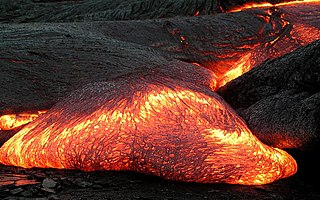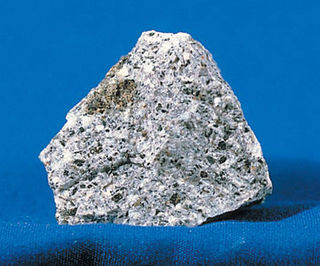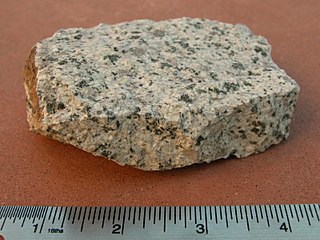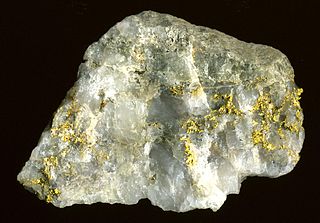
Granite is a coarse-grained (phaneritic) intrusive igneous rock composed mostly of quartz, alkali feldspar, and plagioclase. It forms from magma with a high content of silica and alkali metal oxides that slowly cools and solidifies underground. It is common in the continental crust of Earth, where it is found in igneous intrusions. These range in size from dikes only a few centimeters across to batholiths exposed over hundreds of square kilometers.

Magma is the molten or semi-molten natural material from which all igneous rocks are formed. Magma is found beneath the surface of the Earth, and evidence of magmatism has also been discovered on other terrestrial planets and some natural satellites. Besides molten rock, magma may also contain suspended crystals and gas bubbles.

A pegmatite is an igneous rock showing a very coarse texture, with large interlocking crystals usually greater in size than 1 cm (0.4 in) and sometimes greater than 1 meter (3 ft). Most pegmatites are composed of quartz, feldspar, and mica, having a similar silicic composition to granite. However, rarer intermediate composition and mafic pegmatites are known.
Geochemistry is the science that uses the tools and principles of chemistry to explain the mechanisms behind major geological systems such as the Earth's crust and its oceans. The realm of geochemistry extends beyond the Earth, encompassing the entire Solar System, and has made important contributions to the understanding of a number of processes including mantle convection, the formation of planets and the origins of granite and basalt. It is an integrated field of chemistry and geology.

Basalt is an aphanitic (fine-grained) extrusive igneous rock formed from the rapid cooling of low-viscosity lava rich in magnesium and iron exposed at or very near the surface of a rocky planet or moon. More than 90% of all volcanic rock on Earth is basalt. Rapid-cooling, fine-grained basalt is chemically equivalent to slow-cooling, coarse-grained gabbro. The eruption of basalt lava is observed by geologists at about 20 volcanoes per year. Basalt is also an important rock type on other planetary bodies in the Solar System. For example, the bulk of the plains of Venus, which cover ~80% of the surface, are basaltic; the lunar maria are plains of flood-basaltic lava flows; and basalt is a common rock on the surface of Mars.

Syenite is a coarse-grained intrusive igneous rock with a general composition similar to that of granite, but deficient in quartz, which, if present at all, occurs in relatively small concentrations. It is considered a granitoid. Some syenites contain larger proportions of mafic components and smaller amounts of felsic material than most granites; those are classed as being of intermediate composition.

Volcanic rock is a rock formed from lava erupted from a volcano. Like all rock types, the concept of volcanic rock is artificial, and in nature volcanic rocks grade into hypabyssal and metamorphic rocks and constitute an important element of some sediments and sedimentary rocks. For these reasons, in geology, volcanics and shallow hypabyssal rocks are not always treated as distinct. In the context of Precambrian shield geology, the term "volcanic" is often applied to what are strictly metavolcanic rocks. Volcanic rocks and sediment that form from magma erupted into the air are called "pyroclastics," and these are also technically sedimentary rocks.

Monzonite is an igneous intrusive rock, formed by slow cooling of underground magma that has a moderate silica content and is enriched in alkali metal oxides. Monzonite is composed mostly of plagioclase and alkali feldspar.

Various theories of ore genesis explain how the various types of mineral deposits form within Earth's crust. Ore-genesis theories vary depending on the mineral or commodity examined.
The tholeiitic magma series is one of two main magma series in subalkaline igneous rocks, the other being the calc-alkaline series. A magma series is a chemically distinct range of magma compositions that describes the evolution of a mafic magma into a more evolved, silica rich end member. Rock types of the tholeiitic magma series include tholeiitic basalt, ferro-basalt, tholeiitic basaltic andesite, tholeiitic andesite, dacite and rhyolite. The variety of basalt in the series was originally called tholeiite but the International Union of Geological Sciences recommends that tholeiitic basalt be used in preference to that term.

Fractional crystallization, or crystal fractionation, is one of the most important geochemical and physical processes operating within crust and mantle of a rocky planetary body, such as the Earth. It is important in the formation of igneous rocks because it is one of the main processes of magmatic differentiation. Fractional crystallization is also important in the formation of sedimentary evaporite rocks.
The calc-alkaline magma series is one of two main subdivisions of the subalkaline magma series, the other subalkaline magma series being the tholeiitic series. A magma series is a series of compositions that describes the evolution of a mafic magma, which is high in magnesium and iron and produces basalt or gabbro, as it fractionally crystallizes to become a felsic magma, which is low in magnesium and iron and produces rhyolite or granite. Calc-alkaline rocks are rich in alkaline earths and alkali metals and make up a major part of the crust of the continents.

Monzogranites are biotite granite rocks that are considered to be the final fractionation product of magma. Monzogranites are characteristically felsic (SiO2 > 73%, and FeO + MgO + TiO2 < 2.4), weakly peraluminous (Al2O3/ (CaO + Na2O + K2O) = 0.98–1.11), and contain ilmenite, sphene, apatite and zircon as accessory minerals. Although the compositional range of the monzogranites is small, it defines a differentiation trend that is essentially controlled by biotite and plagioclase fractionation. (Fagiono, 2002). Monzogranites can be divided into two groups (magnesio-potassic monzogranite and ferro-potassic monzogranite) and are further categorized into rock types based on their macroscopic characteristics, melt characteristics, specific features, available isotopic data, and the locality in which they are found.

Igneous rock, or magmatic rock, is one of the three main rock types, the others being sedimentary and metamorphic. Igneous rocks are formed through the cooling and solidification of magma or lava.

The Cornubian batholith is a large mass of granite rock, formed about 280 million years ago, which lies beneath much of Cornwall and Devon in the south-western peninsula of Great Britain. The main exposed masses of granite are seen at Dartmoor, Bodmin Moor, St Austell, Carnmenellis, Land's End and the Isles of Scilly. The intrusion is associated with significant quantities of minerals particularly cassiterite, an ore of tin which has been mined since about 2000 BC. Other minerals include china clay and ores of copper, lead, zinc and tungsten.

Metaluminous rocks are igneous rocks that have a molar proportion of aluminium oxide lower than the combination of calcium oxide, sodium oxide and potassium oxide. This contrasts with peraluminous rocks in which the aluminium oxide concentration is higher than the combination, and peralkaline rocks where the alkalis are higher. Most mafic rocks are metaluminous, having neither excess aluminium nor alkalis. In such rocks the alkalis are mostly accommodated in feldspars, and the remaining calcium and minor sodium are found in hornblende and augite.
S-type granites are a category of granites first proposed in 2001. They are recognized by a specific set of mineralogical, geochemical, textural, and isotopic characteristics. S-type granites are over-saturated in aluminium, with an ASI index greater than 1.1 where ASI = Al2O3 / (CaO + Na2O +K2O) in mol percent; petrographic features are representative of the chemical composition of the initial magma as originally put forth by Chappell and White are summarized in their table 1.
The Bolivian tin belt is a mineral-rich region in the Cordillera Oriental of Bolivia. Being a metallogenetic province the Bolivian tin belt is rich in tin, tungsten, silver and base metals. The Bolivian tin belt follows the same bend as the Bolivian orocline. The mineralizations of the belt were formed episodically beginning in the Triassic and with the youngest known mineralizations dating to the Miocene.
I-type granites are a category of granites originating from igneous sources, first proposed by Chappell and White (1974). They are recognized by a specific set of mineralogical, geochemical, textural, and isotopic characteristics that indicate, for example, magma hybridization in the deep crust. I-type granites are saturated in silica but undersaturated in aluminum; petrographic features are representative of the chemical composition of the initial magma. In contrast S-type granites are derived from partial melting of supracrustal or "sedimentary" source rocks.
The alkaline magma series is a chemically distinct range of magma compositions that describes the evolution of an alkaline mafic magma into a more evolved, silica-rich end member.













